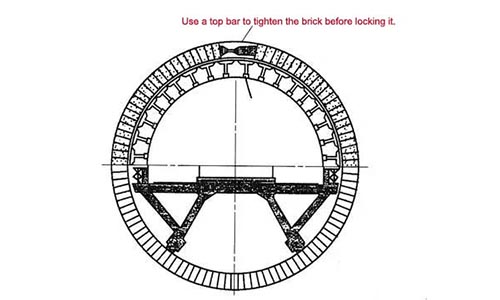Rotary Cement Kiln Refractory
Rotary cement kiln is important thermal equipment for cement industry. By production characteristics, rotary cement kilns are divided into dry rotary cement kilns and wet rotary cement kilns. Rotary cement kiln is composed of steel shell, refractory lining, kiln hood with combustor, cooling machine, dust collector and transmission equipment. Rotary kiln has multiple applications, it is not only used to calcine cement clinker, but also used to calcine high alumina clinker, carbon, magnesite and so on. According to the working temperature and processes, rotary cement kilns are longitudinally divided into 3 zones: preheating zone, sintering zone and cooling zone. To promise the movement of material in the kiln, rotary cement kiln is tilted to certain degree, usually 2.5%~5% of the total length. To prolong the service life, to increase the operation efficiency and to improve economical benefits, kiln lining refractories should be reasonably selected.
Rotary Cement Kiln Refractories Damage Mechanism
The mains factors cause the damage of rotary cement kiln refractories damage are: temperature, chemical corrosion and mechanical abrasion. So refractory material should adapt to the working condition of different zone. different zones have different working temperature, so matched refractory material should be adopted.
Working Temperature and Requirement on Refractory Material
| Parts |
Temperature ℃ |
Requirement |
| Preheating equipment |
800~900 |
Wear resistant refractory, alkali resistant refractory, sulfate corrosion resistant refractory, fluoride corrosion resistant refractory |
| Cyclone pre-heater |
| Grate heater |
| Kiln end |
<900 |
Abrasion resistant refractory |
| Pre-heating zone |
900 |
Abrasion proof refractory |
| Decomposition zone |
900~1200 |
Powder corrosion resistant refractory |
| Transition zone |
1200~1400 |
Thermal shock resistant, chemical corrosion resistant and mechanical impact resistant refractory |
| Sintering zone |
1450 |
High temperature proof, chemical corrosion resistant refractory |
| Cooling zone |
1300~1400 |
Chemical corrosion proof refractory, abrasion proof refractory |
| Kiln hood |
1200 |
Thermal shock resistant, washing resistant refractory |
| Grate cooling machine |
1200 |
Wear proof and thermal shock resistant refractory |
New type dry rotary kiln has larger rotation speed, higher temperature and temperature difference and severer alkali corrosion, so
alkali proof bricks, stripping resistant bricks, refractory castable and insulating material should be applied reasonably.
Alkali Refractory Materials Used in Rotary Cement Kiln
Main alkaline refractory materials used in rotary cement kiln are:
magnesia chrome brick, magnesia brick, spinel brick, dolomite brick etc. magnesia chrome bricks are further divided into regular magnesia chrome brick,
direct bonded magnesia chrome brick,
semi direct bonded magnesia chrome brick, etc.
Alkaline refractory bricks are mainly used in rotary cement kiln sintering zone, transition zone and kiln hood. Spinel brick is one of the main lining materials for large size rotary cement kilns, it gradually replaces magnesite chrome brick and is widely used in transition zone, cooling zone and kiln hood, or even sintering zone.
Alkaline refractory bricks have weak thermal shock resistance, but they have good kiln coating adhesion ability, if proper thickness of kiln coating(200~300mm) is kept, it can compensate the shortcoming of weak thermal shock resistance.To apply spinel brick in sintering zone, the problem of kiln coating adhesion should also be solved.
Magnesia Chrome Bricks Physiochemical Indexes
| Item |
Ordinary magnesia chrome brick |
Semi direct bonded magnesia chrome brick |
Direct boned magnesia chrome brick |
| MgO % |
55~60 |
≥65 |
≥70 |
≥70 |
≥75 |
≥80 |
| Cr2O3% |
8~12 |
8~13 |
≥9 |
≥9 |
≥6 |
≥4 |
| SiO2% |
≤5.5 |
≤4.0 |
≤3.0 |
≤2.8 |
≤2.8 |
≤2.5 |
| Bulk density g/cm3 |
2.85 |
2.90 |
2.98 |
2.98 |
2.95 |
2.93 |
| Apparent porosity % |
23~24 |
20~22 |
≤19 |
≤19 |
≤18 |
≤18 |
| Crushing strength Mpa |
≥20 |
≥35 |
≥40 |
≥40 |
≥40 |
≥40 |
| Refractoriness under load beginning temperature ℃ |
≥1530 |
≥1550 |
≥1580 |
≥1600 |
≥1600 |
≥1600 |
| Linear expansion rate%(1000℃) |
1.0 |
1.1 |
1.01 |
1.03 |
1.05 |
1.05 |
| Thermal shock resistance(1100℃, water cooling) |
≥3 |
≥4 |
≥4 |
≥4 |
≥4 |
≥4 |
Spinel Bricks
| Item |
Fused spinel bricks |
Sintered spinel bricks |
| MgO % |
>78 |
>80 |
| Al2O3 % |
10~13 |
8~12
|
| Fe2O3 % |
<1 |
<1 |
| SiO2 % |
<1.8 |
<1.5 |
| Bulk density g/cm3 |
≥2.92 |
2.92~2.95 |
| Apparent porosity % |
≤19 |
17~19 |
| Crushing strength Mpa |
≥40 |
≥40 |
| Refractoriness under load beginning temperature ℃ |
≥1650 |
≥1650 |
| Linear expansion rate %(1000℃) |
0.96 |
0.99 |
| Thermal shock resistance/ times (1100℃, water cooling) |
≥8 |
≥8 |
Dolomite Bricks
| Item |
Dolomite bricks |
| CaO% |
30 |
| MgO% |
65 |
| Bulk density g/cm3 |
2.8~2.9 |
| Apparent porosity % |
13~15 |
| Cold crushing strength Mpa |
50 |
| Refractoriness under load beginning temperature ℃ |
≥1600 |
| Thermal shock resistance /times(1100℃, air cooling) |
≥3 |

